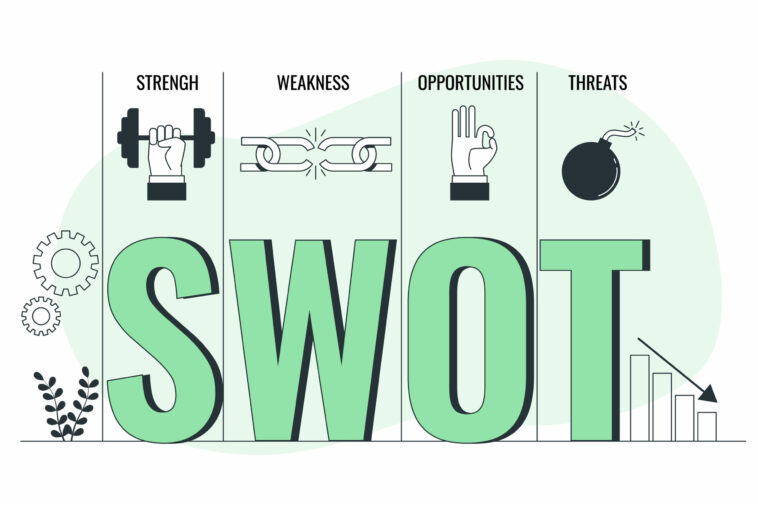In the realm of business strategy and planning, SWOT Analysis stands out as a tried-and-true method, offering comprehensive insights to organizations aiming for growth and sustainability. This technique, focusing on Strengths, Weaknesses, Opportunities, and Threats, provides a structured approach to evaluating internal and external factors influencing an organization’s success. This article delves deep into the intricacies of SWOT Analysis, elucidating its significance, methodology, applications, and real-world impact in shaping business trajectories.
Understanding SWOT Analysis
SWOT Analysis is a strategic planning tool that helps businesses identify their Strengths, Weaknesses, Opportunities, and Threats. This method assists organizations in understanding their internal capabilities and external environments, forming the basis for informed decision-making, strategic alignment, and goal setting.
- Strengths: Internal attributes that give an organization an advantage over its competitors.
- Weaknesses: Internal factors that present disadvantages or hinder the organization’s performance.
- Opportunities: External conditions that the organization can capitalize on for growth and success.
- Threats: External factors that could potentially harm the organization’s position or performance.
The Significance of SWOT Analysis
Conducting a SWOT Analysis is of paramount importance for several reasons:
- Strategic Planning: It lays the foundation for the development of strategic plans, aligning organizational resources and capabilities with market opportunities and challenges.
- Informed Decision-Making: By providing a comprehensive overview of internal and external factors, SWOT Analysis supports informed and balanced decision-making.
- Risk Management: Identifying and understanding threats enable organizations to develop proactive measures to mitigate risks and navigate uncertainties.
- Competitive Advantage: Recognizing and leveraging strengths, while addressing weaknesses, help organizations build and maintain a competitive edge in the market.
Conducting a Comprehensive SWOT Analysis
A thorough SWOT Analysis involves a series of steps to ensure that the resulting insights are relevant, actionable, and conducive to organizational success:
- Define Objectives: Clearly articulate the objectives of the SWOT Analysis in alignment with the organization’s goals and strategies.
- Gather Data: Collect relevant data and information pertaining to internal capabilities and external market conditions.
- Identify Strengths and Weaknesses: Analyze internal factors, considering aspects such as resources, expertise, processes, and organizational structure.
- Recognize Opportunities and Threats: Examine external factors, including market trends, competition, regulatory environment, and technological advancements.
- Formulate Strategies: Develop actionable strategies based on the insights gained, addressing identified weaknesses and threats while capitalizing on strengths and opportunities.
Applications of SWOT Analysis across Industries
SWOT Analysis is versatile and widely applicable across various industries and sectors. From healthcare and education to technology and retail, organizations leverage this technique to gain strategic insights, optimize performance, and navigate market dynamics. By tailoring the approach to industry-specific contexts and challenges, SWOT Analysis remains a relevant and valuable tool for organizations of all types and sizes.
Case Studies: Real-World Impact of SWOT Analysis
Several organizations have successfully employed SWOT Analysis to inform their strategies and drive positive outcomes. Companies such as Apple, Amazon, and Toyota have utilized this method to identify growth opportunities, mitigate risks, and strengthen their market positions. These cases underscore the practical utility and transformative potential of SWOT Analysis in shaping the destinies of businesses.
Challenges and Solutions in SWOT Analysis
While SWOT Analysis is a valuable tool, it is not without its challenges. These include the risk of oversimplification, subjectivity in analysis, and the dynamic nature of business environments. Addressing these challenges requires a balanced and objective approach, continuous monitoring and updating of analysis, and integration with other strategic planning tools and frameworks.
Conclusion
In conclusion, SWOT Analysis stands as an indispensable technique in the strategic planning arsenal of organizations. By offering a structured approach to evaluating internal capabilities and external environments, this method guides informed decision-making, risk management, and strategy formulation. The versatility and applicability of SWOT Analysis across industries, coupled with its real-world impact, underscore its enduring relevance and value in steering organizations toward growth and sustainability.



